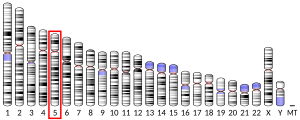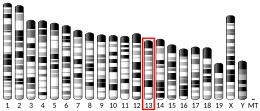PDE4D
cAMP-specific 3',5'-cyclic phosphodiesterase 4D is an enzyme that in humans is encoded by the PDE4D gene.
Function
[edit]The PDE4D gene is complex and has at least 9 different isoforms that encode functional proteins. These proteins degrade the second messenger cAMP, which is a key signal transduction molecule in multiple cell types, including vascular cells (Dominiczak and McBride, 2003).[supplied by OMIM][5]
Interactions
[edit]PDE4D has been shown to interact with myomegalin[6] and GNB2L1.[7][8]
Clinical relevance
[edit]Mutations in this gene have been associated to cases of acrodysostosis.[9]
This is the subtype of PDE4 that appears to be involved in the emetic and antidepressant effects of PDE4 inhibitors.[10]
Furthermore, changes in expression of the isoform PDE4D7 have been proposed as prostate cancer biomarker. [11] [12] [13]
References
[edit]- ^ a b c GRCh38: Ensembl release 89: ENSG00000113448 – Ensembl, May 2017
- ^ a b c GRCm38: Ensembl release 89: ENSMUSG00000021699 – Ensembl, May 2017
- ^ "Human PubMed Reference:". National Center for Biotechnology Information, U.S. National Library of Medicine.
- ^ "Mouse PubMed Reference:". National Center for Biotechnology Information, U.S. National Library of Medicine.
- ^ "Entrez Gene: PDE4D phosphodiesterase 4D, cAMP-specific (phosphodiesterase E3 dunce homolog, Drosophila)".
- ^ Verde I, Pahlke G, Salanova M, Zhang G, Wang S, Coletti D, Onuffer J, Jin SL, Conti M (Apr 2001). "Myomegalin is a novel protein of the golgi/centrosome that interacts with a cyclic nucleotide phosphodiesterase". The Journal of Biological Chemistry. 276 (14): 11189–98. doi:10.1074/jbc.M006546200. hdl:11573/1681344. PMID 11134006.
- ^ Yarwood SJ, Steele MR, Scotland G, Houslay MD, Bolger GB (May 1999). "The RACK1 signaling scaffold protein selectively interacts with the cAMP-specific phosphodiesterase PDE4D5 isoform". The Journal of Biological Chemistry. 274 (21): 14909–17. doi:10.1074/jbc.274.21.14909. PMID 10329691.
- ^ Steele MR, McCahill A, Thompson DS, MacKenzie C, Isaacs NW, Houslay MD, Bolger GB (Jul 2001). "Identification of a surface on the beta-propeller protein RACK1 that interacts with the cAMP-specific phosphodiesterase PDE4D5". Cellular Signalling. 13 (7): 507–13. doi:10.1016/S0898-6568(01)00167-X. PMID 11516626.
- ^ Michot C, Le Goff C, Goldenberg A, Abhyankar A, Klein C, Kinning E, Guerrot AM, Flahaut P, Duncombe A, Baujat G, Lyonnet S, Thalassinos C, Nitschke P, Casanova JL, Le Merrer M, Munnich A, Cormier-Daire V (Apr 2012). "Exome sequencing identifies PDE4D mutations as another cause of acrodysostosis". American Journal of Human Genetics. 90 (4): 740–5. doi:10.1016/j.ajhg.2012.03.003. PMC 3322219. PMID 22464250.
- ^ Zhang HT (2009). "Cyclic AMP-specific phosphodiesterase-4 as a target for the development of antidepressant drugs". Current Pharmaceutical Design. 15 (14): 1688–98. doi:10.2174/138161209788168092. PMID 19442182.
- ^ Böttcher R, Henderson DJ, Dulla K, van Strijp D, Waanders LF, Tevz G, Lehman ML, Merkle D, van Leenders GJ, Baillie GS, Jenster G, Houslay MD, Hoffmann R (Nov 2015). "Human phosphodiesterase 4D7 (PDE4D7) expression is increased in TMPRSS2-ERG-positive primary prostate cancer and independently adds to a reduced risk of post-surgical disease progression". British Journal of Cancer. 113 (10): 1502–11. doi:10.1038/bjc.2015.335. PMC 4815894. PMID 26575822.
- ^ Böttcher R, Dulla K, van Strijp D, Dits N, Verhoef EI, Baillie GS, van Leenders GJ, Houslay MD, Jenster G, Hoffmann R (Oct 2016). "Human PDE4D isoform composition is deregulated in primary prostate cancer and indicative for disease progression and development of distant metastases". Oncotarget. 7 (43): 70669–70684. doi:10.18632/oncotarget.12204. PMC 5342582. PMID 27683107.
- ^ Henderson DJ, Byrne A, Dulla K, Jenster G, Hoffmann R, Baillie GS, Houslay MD (Mar 2014). "The cAMP phosphodiesterase-4D7 (PDE4D7) is downregulated in androgen-independent prostate cancer cells and mediates proliferation by compartmentalising cAMP at the plasma membrane of VCaP prostate cancer cells". British Journal of Cancer. 110 (5): 1278–87. doi:10.1038/bjc.2014.22. PMC 3950871. PMID 24518597.
Further reading
[edit]- Wang Q (May 2005). "Molecular genetics of coronary artery disease". Current Opinion in Cardiology. 20 (3): 182–8. doi:10.1097/01.hco.0000160373.77190.f1. PMC 1579824. PMID 15861005.
- Swinnen JV, Joseph DR, Conti M (Nov 1989). "The mRNA encoding a high-affinity cAMP phosphodiesterase is regulated by hormones and cAMP". Proceedings of the National Academy of Sciences of the United States of America. 86 (21): 8197–201. Bibcode:1989PNAS...86.8197S. doi:10.1073/pnas.86.21.8197. PMC 298247. PMID 2554303.
- Milatovich A, Bolger G, Michaeli T, Francke U (Mar 1994). "Chromosome localizations of genes for five cAMP-specific phosphodiesterases in man and mouse". Somatic Cell and Molecular Genetics. 20 (2): 75–86. doi:10.1007/BF02290677. PMID 8009369. S2CID 19182571.
- Baecker PA, Obernolte R, Bach C, Yee C, Shelton ER (Jan 1994). "Isolation of a cDNA encoding a human rolipram-sensitive cyclic AMP phosphodiesterase (PDE IVD)". Gene. 138 (1–2): 253–6. doi:10.1016/0378-1119(94)90818-4. PMID 8125310.
- Bolger G, Michaeli T, Martins T, St John T, Steiner B, Rodgers L, Riggs M, Wigler M, Ferguson K (Oct 1993). "A family of human phosphodiesterases homologous to the dunce learning and memory gene product of Drosophila melanogaster are potential targets for antidepressant drugs". Molecular and Cellular Biology. 13 (10): 6558–71. doi:10.1128/mcb.13.10.6558. PMC 364715. PMID 8413254.
- Böttcher R, Henderson DJ, Dulla K, van Strijp D, Waanders LF, Tevz G, Lehman ML, Merkle D, van Leenders GJ, Baillie GS, Jenster G, Houslay MD, Hoffmann R (Nov 2015). "Human phosphodiesterase 4D7 (PDE4D7) expression is increased in TMPRSS2-ERG-positive primary prostate cancer and independently adds to a reduced risk of post-surgical disease progression". British Journal of Cancer. 113 (10): 1502–11. doi:10.1038/bjc.2015.335. PMC 4815894. PMID 26575822.
- Böttcher R, Dulla K, van Strijp D, Dits N, Verhoef EI, Baillie GS, van Leenders GJ, Houslay MD, Jenster G, Hoffmann R (Oct 2016). "Human PDE4D isoform composition is deregulated in primary prostate cancer and indicative for disease progression and development of distant metastases". Oncotarget. 7 (43): 70669–70684. doi:10.18632/oncotarget.12204. PMC 5342582. PMID 27683107.
- Henderson DJ, Byrne A, Dulla K, Jenster G, Hoffmann R, Baillie GS, Houslay MD (Mar 2014). "The cAMP phosphodiesterase-4D7 (PDE4D7) is downregulated in androgen-independent prostate cancer cells and mediates proliferation by compartmentalising cAMP at the plasma membrane of VCaP prostate cancer cells". British Journal of Cancer. 110 (5): 1278–87. doi:10.1038/bjc.2014.22. PMC 3950871. PMID 24518597.
- Sette C, Conti M (Jul 1996). "Phosphorylation and activation of a cAMP-specific phosphodiesterase by the cAMP-dependent protein kinase. Involvement of serine 54 in the enzyme activation". The Journal of Biological Chemistry. 271 (28): 16526–34. doi:10.1074/jbc.271.28.16526. PMID 8663227.
- Némoz G, Zhang R, Sette C, Conti M (Apr 1996). "Identification of cyclic AMP-phosphodiesterase variants from the PDE4D gene expressed in human peripheral mononuclear cells". FEBS Letters. 384 (1): 97–102. doi:10.1016/0014-5793(96)00300-6. PMID 8797812. S2CID 42228241.
- Bolger GB, Erdogan S, Jones RE, Loughney K, Scotland G, Hoffmann R, Wilkinson I, Farrell C, Houslay MD (Dec 1997). "Characterization of five different proteins produced by alternatively spliced mRNAs from the human cAMP-specific phosphodiesterase PDE4D gene". The Biochemical Journal. 328 (Pt 2): 539–48. doi:10.1042/bj3280539. PMC 1218953. PMID 9371713.
- Hoffmann R, Baillie GS, MacKenzie SJ, Yarwood SJ, Houslay MD (Feb 1999). "The MAP kinase ERK2 inhibits the cyclic AMP-specific phosphodiesterase HSPDE4D3 by phosphorylating it at Ser579". The EMBO Journal. 18 (4): 893–903. doi:10.1093/emboj/18.4.893. PMC 1171182. PMID 10022832.
- Yarwood SJ, Steele MR, Scotland G, Houslay MD, Bolger GB (May 1999). "The RACK1 signaling scaffold protein selectively interacts with the cAMP-specific phosphodiesterase PDE4D5 isoform". The Journal of Biological Chemistry. 274 (21): 14909–17. doi:10.1074/jbc.274.21.14909. PMID 10329691.
- Beard MB, O'Connell JC, Bolger GB, Houslay MD (Oct 1999). "The unique N-terminal domain of the cAMP phosphodiesterase PDE4D4 allows for interaction with specific SH3 domains". FEBS Letters. 460 (1): 173–7. doi:10.1016/S0014-5793(99)01335-6. PMID 10571082. S2CID 42574718.
- MacKenzie SJ, Baillie GS, McPhee I, Bolger GB, Houslay MD (Jun 2000). "ERK2 mitogen-activated protein kinase binding, phosphorylation, and regulation of the PDE4D cAMP-specific phosphodiesterases. The involvement of COOH-terminal docking sites and NH2-terminal UCR regions". The Journal of Biological Chemistry. 275 (22): 16609–17. doi:10.1074/jbc.275.22.16609. PMID 10828059.
- Miró X, Casacuberta JM, Gutiérrez-López MD, de Landázuri MO, Puigdomènech P (Aug 2000). "Phosphodiesterases 4D and 7A splice variants in the response of HUVEC cells to TNF-alpha(1)". Biochemical and Biophysical Research Communications. 274 (2): 415–21. doi:10.1006/bbrc.2000.3146. PMID 10913353.
- Verde I, Pahlke G, Salanova M, Zhang G, Wang S, Coletti D, Onuffer J, Jin SL, Conti M (Apr 2001). "Myomegalin is a novel protein of the golgi/centrosome that interacts with a cyclic nucleotide phosphodiesterase". The Journal of Biological Chemistry. 276 (14): 11189–98. doi:10.1074/jbc.M006546200. hdl:11573/1681344. PMID 11134006.
- Zauli G, Milani D, Mirandola P, Mazzoni M, Secchiero P, Miscia S, Capitani S (Feb 2001). "HIV-1 Tat protein down-regulates CREB transcription factor expression in PC12 neuronal cells through a phosphatidylinositol 3-kinase/AKT/cyclic nucleoside phosphodiesterase pathway". FASEB Journal. 15 (2): 483–91. doi:10.1096/fj.00-0354com. PMID 11156964. S2CID 26315564.
- Dodge KL, Khouangsathiene S, Kapiloff MS, Mouton R, Hill EV, Houslay MD, Langeberg LK, Scott JD (Apr 2001). "mAKAP assembles a protein kinase A/PDE4 phosphodiesterase cAMP signaling module". The EMBO Journal. 20 (8): 1921–30. doi:10.1093/emboj/20.8.1921. PMC 125429. PMID 11296225.
- Steele MR, McCahill A, Thompson DS, MacKenzie C, Isaacs NW, Houslay MD, Bolger GB (Jul 2001). "Identification of a surface on the beta-propeller protein RACK1 that interacts with the cAMP-specific phosphodiesterase PDE4D5". Cellular Signalling. 13 (7): 507–13. doi:10.1016/S0898-6568(01)00167-X. PMID 11516626.
- Gretarsdottir S, Sveinbjörnsdottir S, Jonsson HH, Jakobsson F, Einarsdottir E, Agnarsson U, Shkolny D, Einarsson G, Gudjonsdottir HM, Valdimarsson EM, Einarsson OB, Thorgeirsson G, Hadzic R, Jonsdottir S, Reynisdottir ST, Bjarnadottir SM, Gudmundsdottir T, Gudlaugsdottir GJ, Gill R, Lindpaintner K, Sainz J, Hannesson HH, Sigurdsson GT, Frigge ML, Kong A, Gudnason V, Stefansson K, Gulcher JR (Mar 2002). "Localization of a susceptibility gene for common forms of stroke to 5q12". American Journal of Human Genetics. 70 (3): 593–603. doi:10.1086/339252. PMC 384939. PMID 11833004.
- Moon E, Lee R, Near R, Weintraub L, Wolda S, Lerner A (Feb 2002). "Inhibition of PDE3B augments PDE4 inhibitor-induced apoptosis in a subset of patients with chronic lymphocytic leukemia". Clinical Cancer Research. 8 (2): 589–95. PMID 11839681.
- Le Jeune IR, Shepherd M, Van Heeke G, Houslay MD, Hall IP (Sep 2002). "Cyclic AMP-dependent transcriptional up-regulation of phosphodiesterase 4D5 in human airway smooth muscle cells. Identification and characterization of a novel PDE4D5 promoter". The Journal of Biological Chemistry. 277 (39): 35980–9. doi:10.1074/jbc.M204832200. PMID 12121997.

























